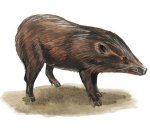 The Pygmy hog (Sus salvanius) is an endangered species of wild pig, and can only be found in the North-east of India in the state Assam. Once they were found throughout Bhutan, Northern India, and Nepal. Estimates of the world population are between 100 and a few hundred individuals. Although they are one of the most threatened species of all mammals, thanks to conservation measures and breeding programs their numbers improve. The reason for their decline is a combination of habitat destruction, overgrazing by domestic livestock, commercial forestry and flood control projects. In the wild they live in tall and dense grassland. Their diet consists of roots, tubers and sometimes insects, invertebrates, eggs and young birds. Pygmy hogs build nests by diggin a trough with their snout and covering it with grasses. This helps them to keep themselves warm in cold weather.
The Pygmy hog (Sus salvanius) is an endangered species of wild pig, and can only be found in the North-east of India in the state Assam. Once they were found throughout Bhutan, Northern India, and Nepal. Estimates of the world population are between 100 and a few hundred individuals. Although they are one of the most threatened species of all mammals, thanks to conservation measures and breeding programs their numbers improve. The reason for their decline is a combination of habitat destruction, overgrazing by domestic livestock, commercial forestry and flood control projects. In the wild they live in tall and dense grassland. Their diet consists of roots, tubers and sometimes insects, invertebrates, eggs and young birds. Pygmy hogs build nests by diggin a trough with their snout and covering it with grasses. This helps them to keep themselves warm in cold weather. Interesting fact: The pygmy hog is the smallest pig in the world.
Links National Geographic article on pygmy hogs conservation
Image of the pygmy hog by Alessio Marrucci, licensed under GFDL
The Pygmy hog is listed as Critically Endangered (CR), facing an extremely high risk of extinction in the wild, on the IUCN Red List of Threatened Species
Namings for the pygmy hog
The females are called 'sow' and males 'boar'. A pygmy hog group is called a 'drift or herd'.Some facts about the
Pygmy hog
Adult weight : 8 kg (17.6 lbs)
Maximum longevity : 14 years
Female maturity :700 days
Male maturity : 700 days
Gestation : 108 days
Litter size : 3
Weight at birth : 0.192 kg (0.4224 lbs)

Custom Search